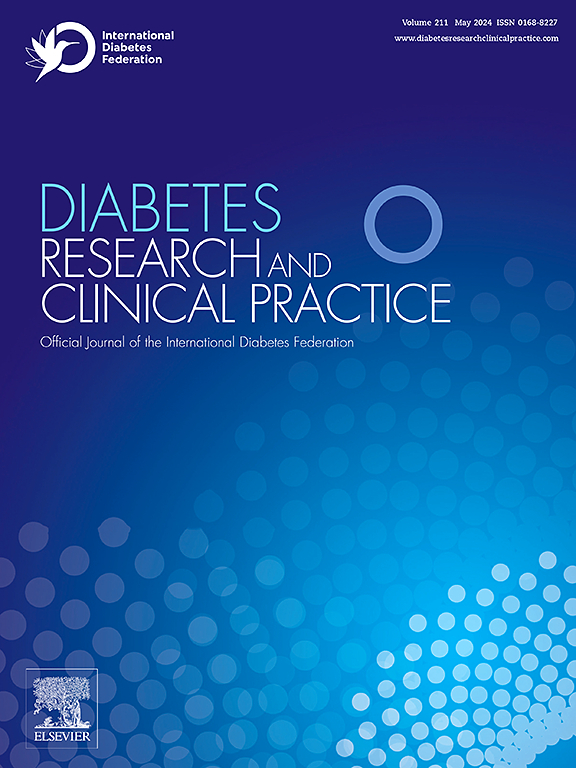连续血糖监测作为1型糖尿病夜间和白天低血糖的分点:来自随机对照HypoDE试验的见解
IF 6.1
3区 医学
Q1 ENDOCRINOLOGY & METABOLISM
引用次数: 0
摘要
目的:本研究重新分析了HypoDE试验的数据,以评估夜间低血糖的患病率,评估连续血糖监测(CGM)对夜间和白天低血糖的影响,并探讨其对严重低血糖(SH)的影响。方法:HypoDE试验是一项随机对照试验,纳入141名患有1型糖尿病、低血糖意识受损或既往SH的成年人。参与者随机分为CGM (Dexcom G5)组或自我血糖监测组(对照组)。结果包括低血糖时间百分比(3.9 mmol/L和3.0 mmol/L)、发作持续时间和SH发生率。结果基线时,夜间低血糖(3.0 mmol/L)暴露比白天高出1.4个百分点(95% CI 0.6-2.2;p & lt;0.002),发作时间延长30.7分钟(CI 21.5-39.9)。使用CGM后,这些差异消失(3.0 mmol/L: 0.3个百分点,CI 0.7-1.3),而对照组则持续存在。白天低血糖显著增加SH风险(IRR 1.10 /个百分点,CI 1.01-1.21;IRR 1.04 /分钟,CI 1.01-1.07)。结论scgm可有效降低夜间和日间低血糖。如果没有CGM,夜间低血糖会增加白天的风险,而白天低血糖会增加SH的风险。在资源有限的情况下,扩大CGM的获取和解决夜间低血糖问题至关重要。临床试验网站:NCT02671968。本文章由计算机程序翻译,如有差异,请以英文原文为准。
Continuous glucose monitoring as equinox of nocturnal and daytime hypoglycaemia in type 1 diabetes: insights from the randomized controlled HypoDE trial
Aims
This study re-analysed data from the HypoDE trial to assess the prevalence of nocturnal hypoglycaemia, evaluate the impact of continuous glucose monitoring (CGM) on nocturnal and daytime hypoglycaemia, and explore their influence on severe hypoglycaemia (SH).
Methods
The HypoDE trial was a randomized controlled trial involving 141 adults with type 1 diabetes, impaired hypoglycaemia awareness, or prior SH. Participants were randomized to CGM (Dexcom G5) or self-monitoring of blood glucose (control). Outcomes included the percentage of time spent in hypoglycaemia (<3.9 mmol/L, <3.0 mmol/L), episode duration, and SH incidence.
Results
At baseline, nocturnal hypoglycaemia (<3.0 mmol/L) exposure exceeded daytime by 1.4 percentage points (95 % CI 0.6–2.2; p < 0.002), with episodes lasting 30.7 min longer (CI 21.5–39.9). Using CGM, these differences disappeared (<3.0 mmol/L: 0.3 percentage points, CI 0.7–1.3), while they persisted in the control group. Daytime hypoglycaemia significantly increased SH risk (IRR 1.10 per percentage point, CI 1.01–1.21; IRR 1.04 per minute, CI 1.01–1.07).
Conclusions
CGM effectively reduced nocturnal and daytime hypoglycaemia. Without CGM, nocturnal hypoglycaemia contributes to daytime risks, while daytime hypoglycaemia elevates SH risk. Expanding CGM access and addressing nocturnal hypoglycaemia in resource-limited settings are critical.
Trial registrationClinicaltrials.gov: NCT02671968.
求助全文
通过发布文献求助,成功后即可免费获取论文全文。
去求助
来源期刊

Diabetes research and clinical practice
医学-内分泌学与代谢
CiteScore
10.30
自引率
3.90%
发文量
862
审稿时长
32 days
期刊介绍:
Diabetes Research and Clinical Practice is an international journal for health-care providers and clinically oriented researchers that publishes high-quality original research articles and expert reviews in diabetes and related areas. The role of the journal is to provide a venue for dissemination of knowledge and discussion of topics related to diabetes clinical research and patient care. Topics of focus include translational science, genetics, immunology, nutrition, psychosocial research, epidemiology, prevention, socio-economic research, complications, new treatments, technologies and therapy.
 求助内容:
求助内容: 应助结果提醒方式:
应助结果提醒方式:


